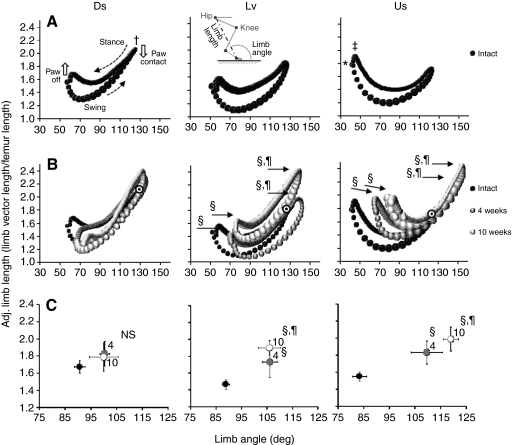Fig. 2.
Kinematics of the hindlimb. (A) The adjusted limb length (i.e. quotient of limb length and femur length) plotted against limb angle for Ds, Lv and Us walking of intact rats (black bubbles). The locations of the hip, knee, ankle and MTP joints are shown in the inset in the Lv panel. Limb length (dot-dash line) and limb angle (dotted line) are the magnitude and direction, respectively, of the position vector between the hip and MTP joints. Limb length was calculated as the distance between the hip and MTP joint in every video frame. Limb angle was calculated as the angle between the treadmill belt and the calculated limb on the rostral side. The foot angle was calculated as the angle between the line intersecting the ankle and MTP joints and the treadmill belt on the caudal side. (B) Data from injured animals (gray bubbles) overlaid on the data from intact animals. Each trace forms a complete loop and is the average of seven rats walking at a treadmill speed of 11 m min–1. Each value is the inter-rat average. The size of the bubbles is proportional to the s.e.m. Bubble size is a general measure of variability about each data point and is not intended to be a precise depiction of the s.e.m. in either direction. The step cycle starts at paw contact and advances counter-clockwise, as indicated by dotted arrows above and beneath the object in A Ds. The upper portion of the object defined by these points is stance and the lower portion is swing. Circular black and white targets identify maximal adjusted femur lengths from intact rats where post-operative data obscure intact data. (C) The average (± s.e.m.) of these measures of hindlimb position from the data in B. Significant changes in average position after nerve injury (4 weeks and 10 weeks compared with Intact) were found for Lv and Us walking. 4 and 10 weeks were not significantly different from each other. There were no significant differences for Ds walking. *P<0.05 vs Ds (angle); †P<0.05 vs Lv and Us (length); ‡P<0.05 vs Ds and Lv (length); §P<0.05 vs intact (angle); ¶P<0.05 vs intact (length); NS, not significant.

